Many German neo-Nazis are trying to develop the "völkisch" community as a revival of the "Volksgemeinschaft" ("German ethnic community") in National Socialism. "Völkisch" is a national socialist term, coming from the ideo of the "volk," or people, conceptualizing the German ethnic – or the so-called "Aryan" – understanding, constituting the principal pillar of the "Volksgemeinschaft," a concept that includes six components: the "anti-society," the "blood community," the "unified community," the "community of the people," the "Führer principle," and the "common enemy."
YOU MUST BE SUBSCRIBED TO THE MEMRI DOMESTIC TERRORISM THREAT MONITOR (DTTM) TO READ THE FULL REPORT. GOVERNMENT AND MEDIA CAN REQUEST A COPY BY WRITING TO DTTMSUBS@MEMRI.ORG WITH THE REPORT TITLE IN THE SUBJECT LINE. PLEASE INCLUDE FULL ORGANIZATIONAL DETAILS AND AN OFFICIAL EMAIL ADDRESS IN YOUR REQUEST. NOTE: WE ARE ABLE TO PROVIDE A COPY ONLY TO MEMBERS OF GOVERNMENT, LAW ENFORCEMENT, MEDIA, AND ACADEMIA, AND TO SUBSCRIBERS; IF YOU DO NOT MEET THESE CRITERIA PLEASE DO NOT REQUEST.
The education of the youth played a key role in solidifying the Volksgemeinschaft in the Third Reich. In some cases, indoctrination commenced in the nursery through toys that promoted the ideology of the Nazi regime. The propaganda apparatus promoted the dogma and ideals of the national socialist regime to the youth. It was effectively implemented by influencing young people in the spirit of these National Socialist educational dogmas within the framework of the Hitler Youth.
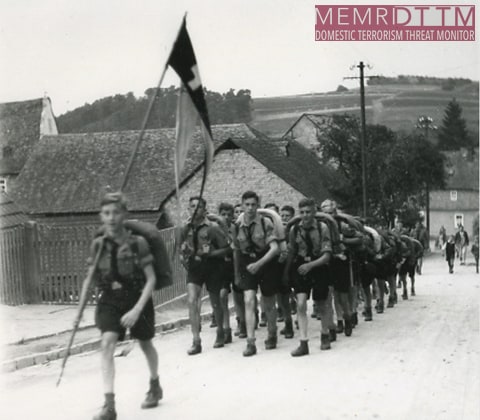
The regional Weilburg Hitler Youth marching in the Weilburg region, 1933-1939

Hitler Youth raising the flag in the morning at The Fähnlein tent camp in Bilstein in June 1939.

Students boxing at the Napolenta Schulpfortanin 1940.
Neo-Nazi Gatherings Aim To Revitalize The Concept Of A Volksgemeinschaft And Pursue Its Revival
Despite the challenges in reviving the concept of the Volksgemeinschaft in the Federal Republic of Germany, German neo-Nazi parties and organisations emphasize building strong and unified youth branches, including the "Young Nationalists," the youth organization of the neo-Nazi party "Die Heimat" formerly operating under the name "National Democratic Party" (NPD); the "National Revolutionary Youth," the youth branch of the "Ill. Weg" party; the "Neue Starke [New strength]" party; the "Young Alternative," the youth organization of the ultranationalist party "Alternative for Germany" (AfD), and other factions affiliated with the German-speaking Identitarian movement operating also in Austria and Switzerland. Within the framework of these various entities, collective weekend gatherings are periodically organized simulating past Hitler youth meetings and seasonal camps in pursuit of the motto: "We must educate a new man, so that our people will not perish from the degeneration phenomena of the zeitgeist" citing Adolf Hitler during his speech at the 1935 NSDAP party congress in Nuremberg.
Like the principle of the Hitler Youth, neo-Nazi youth gatherings aim to educate and train youths physically, mentally, and morally in the spirit of National Socialism for the service to the people and the Volksgemeinschaft. To revive the pursuit of strengthening willpower, loyalty, and duty and facilitate the development of a kind of "Volksgemeinschaft" among the German people, neo-Nazi groups offer an array of activities integrated in their gathering curricula such as lectures serving ideological indoctrination, strength and endurance training, boxing, flag raising and torch ceremonies, recitals, community hiking tours, and other scouting activities.
The Federal Office for the Protection of the Constitution appear incapable of tracing the gatherings despite their visible resemblance to the Hitler Youth and thus constituting unconstitutional activity. Such neo-Nazi gatherings, although heavily ideological, promote themselves as ordinary community gatherings or hiking weekends. Weekend camps organized by neo-Nazis are in particular part of the strategy to undermine the democratic order.
Impressions Of Neo-Nazi Hitler Youth-Inspired Gatherings Published On Telegram Channels
German neo-Nazi groups often release photos from their community-building day and weekend gatherings, during which members can network and consolidate overall neo-Nazi organizational structures.
On its webpage, the "III.Weg" posted on June 11 a report titled "NRJ Day in Berlin" featuring photos from the June 10 community day in Berlin organized by the party's youth branch "National Revolutionary Youth" (NRJ). Alongside activities including boxing, weight training, ideological education, and generally consolidating the community, new members were recruited and introduced to the activities of the NRJ. The report concluded with the words: "Our National Revolutionary Youth is growing and becoming increasingly attractive to the young people of our nation."
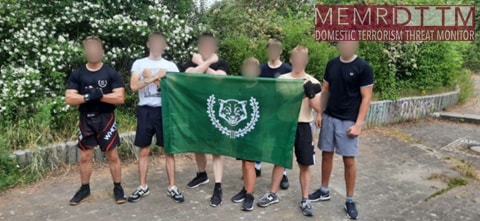
Seven NRJ members, whose faces have been digitally blurred, pose with the NRJ flag.
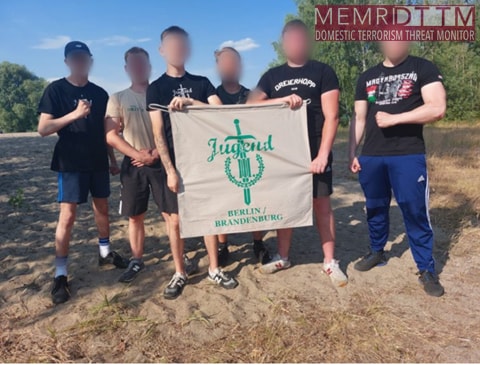
Six members of the "Ill. Weg" youth branch, whose faces have been digitally blurred, pose with a flag of the Berlin-Brandenburg branch of NRJ.
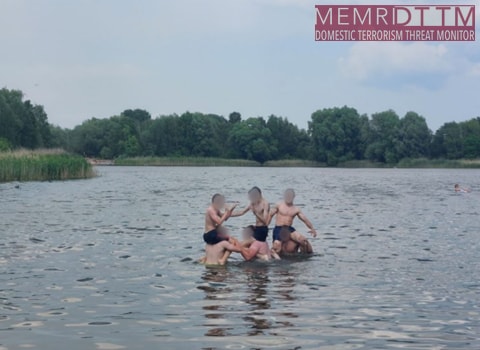
Six NRJ members can be seen in the water engaging in arm wrestling.
On Telegram, the West Saxony branch of "Ill.Weg" posted on April 19 a photo collage featuring impressions from the gathering in the city of Zwickau held in mid-April. Members of the NRJ, whose faces have been digitally blurred, pose with lit flares paired with a large banner inscribed with the slogan: "Youth Needs Freedom!" and accompanied by the NRJ emblem. Other photos show men lifting weights and playing cards and darts.
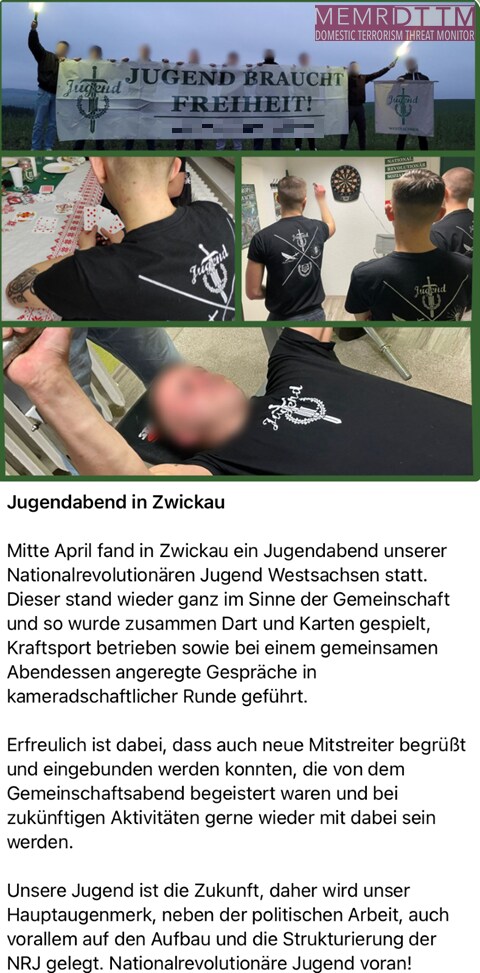
NRJ posted on March 26 on its Telegram channel a graphic comprising photos from its organized March 25 "Day of the German Youth 2023" including boxing training. The channel wrote: "Fight the battle of youth, do not fade away. Strengthen your body, your mind, regard it as your duty [...] you must scatter the seeds of the future! Sports, action, community [...] struggle and education in purity, this was the day of strength-sapping sports training, community advocacy, political activism, and enrichment through words."
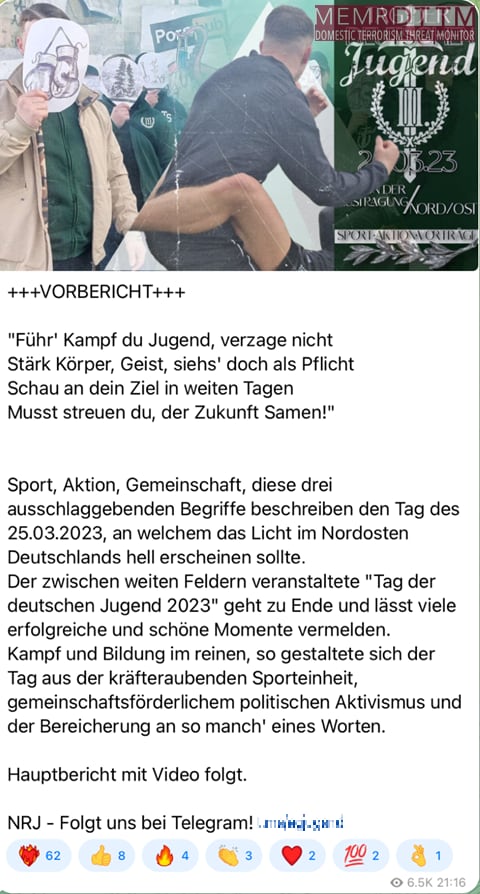
"Young Nationalists" (JA) posted on June 3 on its Telegram channel a photo collage featuring impressions from its party congress, which capture the traditional flag marching ceremony. Activists, accompanied by a drummer, stand in line holding the German flag and JA flags.
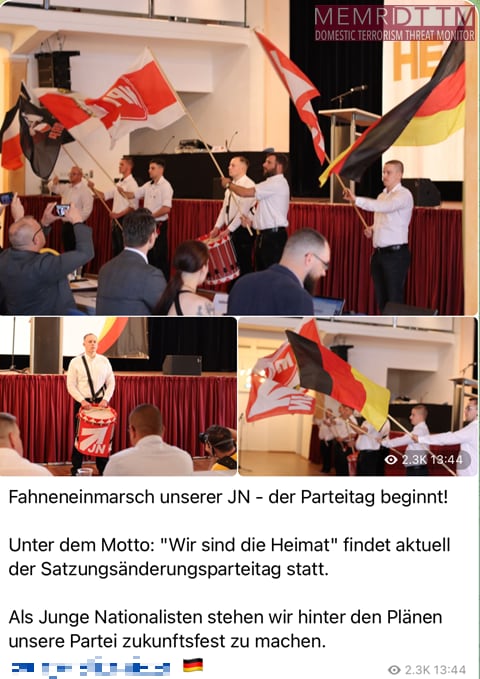
On its webpage, the "Young Nationalists" published on April 18 an article titled: "JN – Meeting of the Generations 2023" reporting on the second JN-organized "Meeting of the Generations" held on April 15-16 at the "Volks Fliederhaus" community center and regional office of its mother party "Die Heimat" located in the town of Eisenach in Thüringen. With the words: "JN – a life alliance in the fight for the people and the fatherland," the post described the plan for the weekend, including the hosting of party members who were active in various decades since the founding of the youth branch in 1969. JA chariman Sebastian Weigler and Franconian activists gave slideshow presentations reviewing JA activism over the years. JA member and songwriter Benjamin Gruhn led a recital featuring "old resistance songs." A hiking tour to the Burschenschaft Mahnmal, a war memorial situated in Eisenach was listed on the agenda for Sunday, April 16.

JA members in a flag ceremony.
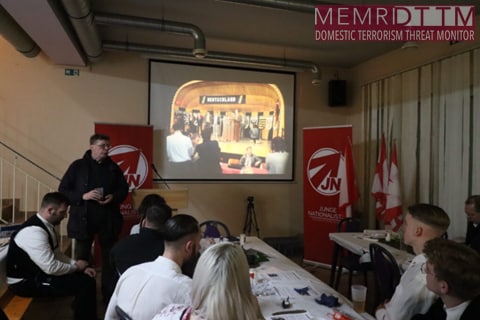
A JA member giving a presentation.
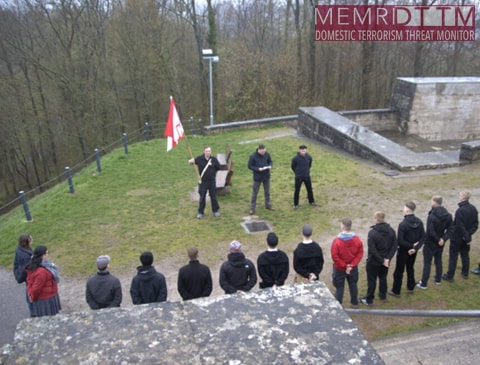
A group of JA members can be seen engaging perform a flag-raising ceremony at the "Burschenschafts Mahnmal" in Eisenach.
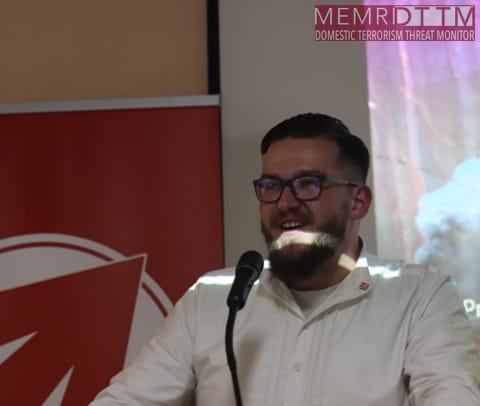
JA federal charmer Sebastian Weigler giving a speech.
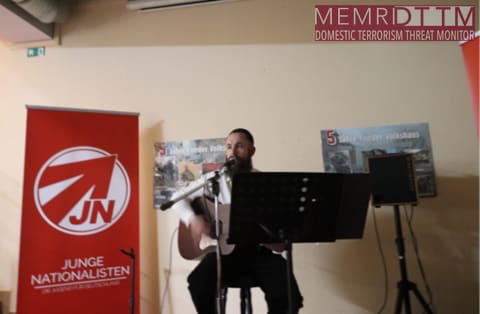
JA member and songwriter Benjamin Gruhn performing at the "Volks Fliederhaus."
The full text of this post is available to DTTM subscribers.
If you are a subscriber, log in here to read this report.
For information on the required credentials to access this material, visit the DTTM subscription page







